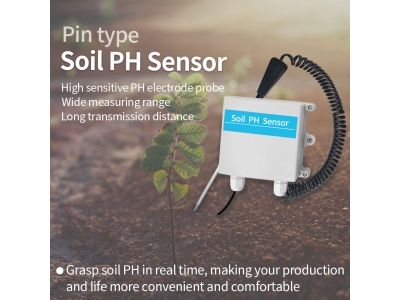
Soil moisture sensors for irrigation scheduling
with the advent of soil moisture sensors, farmers can now monitor soil moisture levels in real-time and adjust irrigation schedules accordingly. In this article

with the advent of soil moisture sensors, farmers can now monitor soil moisture levels in real-time and adjust irrigation schedules accordingly. In this article
Irrigation scheduling is a critical component of modern farming practices, enabling farmers to optimize water usage and crop yields. Traditionally, irrigation schedules were based on estimates of soil moisture or weather conditions, which could lead to over or under-irrigation and reduce crop productivity. However, with the advent of soil moisture sensors, farmers can now monitor soil moisture levels in real-time and adjust irrigation schedules accordingly. In this article, we will explore the use of soil moisture sensors for irrigation scheduling, including installation, calibration, data interpretation, and practical tips for optimal sensor performance.
Installation: Proper installation of the soil moisture sensor is essential for accurate and reliable measurements. Follow these steps for successful installation:

Select a representative location in the field where you want to monitor soil moisture.
Dig a hole or trench in the soil at the desired depth (usually 10-15 cm) and insert the sensor probe into the hole.
Ensure that the sensor probe is firmly in contact with the surrounding soil and there are no air gaps around it.
Cover the hole with soil to secure the sensor in place.
Repeat the installation process at multiple locations for a comprehensive understanding of soil variability.
Calibration: Calibration is necessary to ensure accurate readings from the soil sensor. Follow these general calibration steps:
Check the manufacturer's instructions for specific calibration procedures.
Before installation, allow the sensor to stabilize in the target environment for a recommended period.
Calibrate the sensor using a calibration standard or known soil moisture values.
Adjust the sensor's settings or calibration coefficients based on the calibration results.
Regularly check and recalibrate the sensor to account for any drift or changes in environmental conditions.
Data Interpretation: Interpreting the data collected by the soil moisture sensor is crucial for effective decision-making. Consider the following points:
Understand the sensor's output units and measurement scales for soil moisture.
Monitor the data trends over time to identify patterns and correlations with crop growth, irrigation schedules, or weather conditions.
Use visualizations such as graphs or charts to analyze the data and detect any anomalies or unexpected changes.
Compare the sensor data with other relevant environmental factors, such as rainfall or temperature, for a comprehensive understanding of soil moisture dynamics.
Irrigation Management: Soil moisture sensors provide valuable information for optimizing irrigation practices. Consider the following tips:
Set appropriate soil moisture thresholds based on the crop's water requirements and growth stage.
Use the sensor data to schedule irrigation events, ensuring optimal soil moisture levels and minimizing water wastage.
Implement automated irrigation systems that integrate with the soil sensor data, allowing for precise and efficient water delivery.
Consider using soil moisture sensors in conjunction with other irrigation scheduling methods, such as weather-based or plant-based approaches, for a more comprehensive management strategy.
Crop Health Monitoring: Monitoring soil moisture helps assess crop health and detect potential issues. Consider the following practices:
Track soil moisture levels to avoid under or overwatering, which can lead to plant stress or diseases.
Combine the soil sensor data with other plant health indicators, such as leaf color, growth rate, or pest presence, for early detection of crop problems.
Adjust irrigation schedules based on the crop's response to different soil moisture levels, such as wilting or leaf turgor.
Maintenance and Troubleshooting: Regular maintenance and troubleshooting are essential for the proper functioning of the soil sensor. Follow these guidelines:
Clean the sensor regularly to remove any debris or buildup that may interfere with accurate measurements.
Check the sensor cables and connections for any signs of damage or wear.
Monitor the sensor's battery or power supply to ensure continuous operation.
Calibrate the sensor periodically to account for any drift or changes in environmental conditions.
Consult the manufacturer's manual or reach out to technical support if you encounter any issues or need assistance.
Conclusion:
Soil moisture sensors are valuable tools for modern irrigation scheduling practices, enabling farmers to optimize water usage and crop yields. Proper installation, calibration, and data interpretation are essential for accurate and reliable measurements. By using the sensor data to schedule irrigation events, farmers can minimize water wastage and reduce the risk of crop stress or diseases. Regular maintenance and troubleshooting ensure the longevity and accuracy of the sensor. Remember to consider the specific requirements of your crops and consult with experts or agronomists for personalized guidance. With reliable soil moisture data, you can enhance your irrigation scheduling practices, conserve water resources, and improve crop productivity.